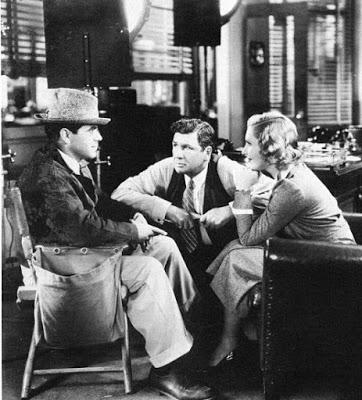
Big, blustery George Bancroft was in his mid-40s when he became a film star, breaking out in 1927 with a linchpin performance as mob boss "Bull Weed" in Underworld, Josef von Sternberg's prototypical gangster film. Bancroft was third-billed under dependably wooden Clive Brook, fluttery leading lady Evelyn Brent, and he stole the show with his powerhouse portrayal of a hoodlum with a heart.
Bancroft would team with von Sternberg again in 1928 for another of the director's great silent classics, The Docks of New York, and become Paramount Pictures' top star. He followed with the titular role in The Wolf of Wall Street (1929), a title that would be appropriated many decades later by a New York stock trader as his nickname, the title of his memoir and Martin Scorsese's 2013 film adaptation. Bancroft's next film would take him to the peak of his career as a lead actor when, in 1930, he earned a Best Actor nomination in the second year of the Academy Awards for his star turn in Thunderbolt (1929). This would be his third and final film with Josef von Sternberg, who then moved on to discover and mentor Marlene Dietrich.
George Bancroft as rough-hewn Bill Roberts, stoker on a tramp steamer, in The Docks of New York:
We catch just a momentary glimpse of Bancroft in his Oscar-nominated performance as vengeful criminal "Thunderbolt" Jim Lang in this brief clip from Thunderbolt. The scene is set in Harlem and the singer is Theresa Harris:
According to existent reports, all of this this success dramatically swelled the head of the popular actor and he became a handful on the Paramount lot. John Cromwell, who directed Bancroft on four films following Thunderbolt, three of them in succession, "...discovered a lot about George very quickly...you almost immediately encountered this terrific ego."
Among the amusing tales of Bancroft's inflated self-regard during his superstar phase is this one: When he found out studio head B.P. Schulberg and his wife were taking a European vacation (Bancroft being a chief reason his boss wanted to get away) he insisted that he and his wife join them. At the time, sound was coming in and Bancroft's contract with Paramount was coming up for negotiation. So, while they were in Germany, Schulberg decided to make a point that he hoped would sway the terms of Bancroft's contract in the studio's favor " You see, George," he told the actor, "we lose all this business in Germany because you don't speak German - and they don't understand English." The actor considered this. "Well..." he replied, "when they know it's Bancroft, they'll learn English!" Another story tells of the actor refusing his director's order that he fall to the ground when shot by a villain. According to the anecdote, Bancroft argued, "One bullet can't kill Bancroft!
Cromwell attributed Bancroft's basic confidence in himself as an actor to his stage background and the fact that he had "an excellent voice - wonderful voice - and knew pretty well how to use it." This was especially meaningful at a time when many of those without theater experience or voice training were losing their careers as sound took over. But the actor was pushing 50 as the 1930s arrived, and so, as Marlene Dietrich's star rose at the studio, his run as Paramount's most important onscreen asset would shortly come to an end. He would be top-billed in eight more films through 1932, but in only two from 1933 - 1936. Then his late career stint as a character actor would shift into gear, and it would begin with a perfectly juicy role in one of Frank Capra's best, Mr. Deeds Goes to Town (1936/Columbia). Bancroft would be third-billed as "MacWade," Jean Arthur's garrulous newspaper editor...
There would be two more leading roles in George Bancroft's filmography, but both were in second-tier programmers, A Doctor's Diary (1937) for Paramount, and Racketeers in Exile (1937) for Columbia. He played the titular MD in the first film and a criminal-turned-evangelist in the latter.
Bancroft would fare better in his next outing, John Ford's Submarine Patrol (1938), an action/drama set during World War I. Though minor Ford, it provided Bancroft with a plum supporting role as a rough and tumble sea captain/father of the leading lady - and it gave him the opportunity to work with and make an impression on the great director.
Then came Michael Curtiz's Angels with Dirty Faces (1938/Warner Bros.), and Bancroft would once more play a crook, this time contending with hoodlum-on-the-rise James Cagney (and a somewhat less-than-tough Humphrey Bogart):
My favorite of George Bancroft's character roles is "Marshal Curley Wilcox" in one of the best of all Westerns, John Ford's Stagecoach (1939/Walter Wanger/United Artists). Bancroft was in very good company; there are more than a few fine character parts and players in that classic (Mitchell, Carradine, Devine), not to mention John Wayne in his break-out performance and an incandescent Claire Trevor. As "Curley," Bancroft is riding shotgun next to Andy Devine when John Wayne makes his iconic entrance as "The Ringo Kid."
Bancroft's "Curley" is a slightly softened rendition of the actor's specialty, the larger-than-life dynamo. A big lug, he's a gruff take-charge, no-nonsense lawman and also a stand-up guy with a good heart and an occasional understanding word or to. Bancroft was well cast as the fellow in charge of the harrowing trip - and he turned out to be a great foil for Andy Devine's scatter-brained dizziness, too.
He would work for three more years and make several more films for a variety of directors and studios, including an MGM vehicle for Mickey Rooney as Young Tom Edison (1940), wherein Bancroft played Tom's dad. His name would never fall too far down in the credits, but the "A" pictures would become fewer as time passed.
In 1942, after 20 years in the movies, George Bancroft, age 60, retired from acting to tend his 48 acre ranch in the San Fernando Valley. It is said he retired a millionaire.
This is my entry in the annual What a Character! blogathon hosted by Once Upon a Screen, Outspoken and Freckled and Paula's Cinema Club.

Frank Capra, George Bancroft and Jean Arthur on the set of Mr. Deeds Goes to Town
References:
American Classic Screen Profiles, edited by John C. Tibbetts and James M. Welsh (Scarecrow Press, 2010)Fun in a Chinese Laundry by Josef von Sternberg (MacMillan, 1965)

